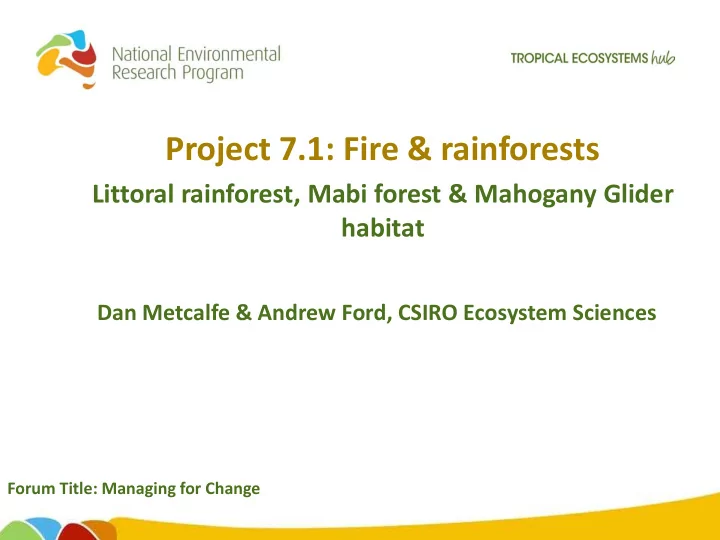

Project 7.1: Fire & rainforests Littoral rainforest, Mabi forest & Mahogany Glider habitat Dan Metcalfe & Andrew Ford, CSIRO Ecosystem Sciences Forum Title: Managing for Change
BACKGROUND • Fire is a natural modifier of vegetation composition, structure and distribution • Fire has been used as a management tool by indigenous people for 000’s of years • Fire regimes changed under European management approaches
RELEVANCE OF WORK • Fire is a management tool required to maintain ecosystem health within the Wet Tropics landscape • Require empirical evidence to support policy and management strategies around application or exclusion of fire • Climate change scenarios suggest that fire is likely to be a significant contributor to landscape transformation
RESULTS Mahogany glider habitat: • absence of fire allows rainforest to invade • invasions < 5 years old reversed with fire • invasions > 10 years old require very high fire intensities • fire changes recruitment and survival patterns
RESULTS Mabi forest • seasonally dry forest types may support litter fires in exceptionally dry years •Such fires may be important in weed control and promoting tree recruitment • off-site experimental combustion will determine conditions under which fire possible • microclimatalogical data will indicate frequency of such events • climate change scenarios suggest increases?
RESULTS Littoral rainforest • fire is a significant threat to persistence • weed invasion, fire in adjacent communities and agricultural/urban environments pose risk • pilot study mapping littoral rainforest extent, condition and threats • work with agencies, community and traditional owner groups to improve management and protection
APPLICATION OF WORK • Recognise the importance of fire in Wet Tropics landscape, both as a positive and negative influence • Suggest appropriate fire regimes for different vegetation types • Incorporate traditional ecological knowledge into management understanding of the role of fire • Provide empirical data to underpin policy decisions and management strategies • Inform the discussion about how future climate scenarios will change management imperatives
FUTURE DIRECTIONS • conservation advice on littoral and lowland rainforests • experimental fire for weed control in Mabi forest • amended fire management recommendations for Mahogany Glider habitat • incorporation of TEK into fire management policy development • improved understanding of fire in transitional and potentially transformative role in Wet Tropics landscapes under climate change
THANK YOU c osyste m Sc ie nc e s , Athe rto n, Brisb a ne & CSIRO E Ca nb e rra e rra in NRM – Athe rto n, I nnisfa il & Missio n Be a c h sta ff T Que e nsla nd Pa rks & Wildlife – Athe rto n & I ng ha m sta ff Ca ssowa ry Coa st Re g iona l Counc il Ra infore st Aborig ina l Pe ople ’s Allia nc e We t T ropic s Ma na g e me nt Authority
Recommend
More recommend